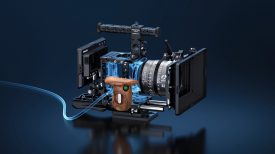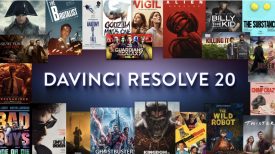By Matt Allard
I was pretty much sold on the Sony F3 before it had even been launched at NAB. After seeing a film called “Compulsion” by Jason Wingrove on Vimeo it was a done deal in my mind to go and purchase. Jason had shot this piece down at one of Sydney’s sea pools at North Narrabeen, a spot I know very well. So when I was recently back in Sydney, Australia on holidays I decided to make a short film thanks to Jason’s inspiration. My parents live up on the Northern beaches and every morning they go swimming in these sea pools which are basically outdoor swimming pools built into the natural surroundings. The pools are very unique to Sydney and are not found anywhere else in Australia. They were originally built in the 1930’s because of the fear of shark attacks.
Saltwater from Matthew Allard on Vimeo.
The people who go down and swim every morning usually go regardless of the weather. I was originally just going to shoot pictures but decided instead to make it more documentary style. I didn’t have any proper microphones with me so I improvised and just set the camera up very close to the people I interviewed and used the camera’s top mic. This worked out fine as I didn’t intend on using anything other than the audio from the interview clips over overlay over my images.
It’s easy to just go and shoot some pretty pictures and put them to music, but I wanted to give the piece some soul. And so I gathered voices from real people, doing real things. I interviewed about six people and only recorded their voice as I felt they were a lot more comfortable chatting to me knowing they weren’t being filmed. Their answers were from the heart; raw and honest. By making interviews more like a conversation you tend to get better answers.
Australia’s eastern coastline also provides some amazing sunrises. I got up over several days at 5am to go shoot the sea pools and surfers. Sunrises where you are trying to not only show the sun, but also the surroundings, test the highest limits of a camera’s dynamic range. I wasn’t using an external recorder so I didn’t want to record Sony’s straight S-log tone curve to the SxS memory cards. This tone curve is designed to give the maximum possible latitude in an image when post processed but requires some effort. What I did after doing a bit of experimenting was to record in the S-log mode but with a REC709 (800%) LUT applied. I found this gave me most of the benefits of S-log but still made the image easily gradable in post. The key when using S-log is to protect your highlights. If you do it’s amazing how much detail you can recover. If you blow your highlights out you can never get them back.
Getting up early is worth it for anything you are shooting. There is something so special about that time just before sunrise and just after. The first morning I got up it was very cloudy and overcast and I was worried I wasn’t going to get a sunrise. When I arrived at the beach I was pleasantly surprised. Dark clouds, big surf and just enough of a gap on the horizon to see the sun come up. The F3’s ability (especially using S-log) to handle super high ‘contrasty’ scenes still amazes me. The camera could hold in the highlights of a strong rising sun while still showing the subtlety in the clouds and the detail in the shadows of the rock pools. I primarily used the Nikon 80-200mm f2.8 and a Zeiss 21mm f2.8 lenses for this shoot. There was some footage shot at 720/50p in camera to achieve the slow motion shots. I didn’t want it all to be slow motion as it was important for me to showcase how the water and light moved in real-time. It was also important to have a lot of natural sound and not to just put it to music.
All the locations presented me with different lighting conditions; from stormy clouds to harsh morning sun, every spot presented a unique challenge. Knowing how your camera works and what it can and cannot do are key. If you use your camera’s strengths and hide its weaknesses, it is easier to achieve good results.
I used surfing footage shot in a GoPro action cam by a good friend of mine, Steve Clements. He used to be a professional surfer and now his son Koby is also joining him down in the water. The GoPro vision was shot at 60p and then converted in Cinema tools to 25p.
Hopefully this piece showcases the natural beauty of Sydney’s northern beaches, as well as give you an insight into how the surroundings make the people who live there feel. The key to any film you shoot is if people watch it and feel something from it. Good characters make a story or a film. Without them it lacks a soul. Being a good story teller is sometimes letting other people tell the story for you.
I shot all this footage at Avalon, Collaroy, North Narrabeen and Long Reef beaches in Sydney. This wasn’t a paid assignment – it was just me and my camera, going out and doing what I love.
About Matthew Allard, Aljazeera Senior Field Cameraman, Kuala Lumpur:
Matt has been a Camera/Editor in TV news for more 20 years, previously working for both Channel 9 and Channel 10 in Australia. Twice Network Ten Australia’s cameraman of the year as well as being a Walkley Finalist for outstanding camerawork in 2006 (for coverage of the Cronulla Race Riots) and a Logie Finalist for outstanding news coverage 2006 (Bali 9). He is a multiple ACS (Australian Cinematographers Society) award winner. His Sword Maker story that was shot on a 7D won the prestigious Neil Davis International News Golden Tripod at the 2011 ACS Awards. He has covered news events in more than 35 countries, from major sporting events to terrorist bombings. Based out of the Kuala Lumpur broadcast centre in Malaysia he is an avid user and follower of new technology, shooting stories on HD broadcast cameras, the Sony F3 as well as new Canon DSLRs.






